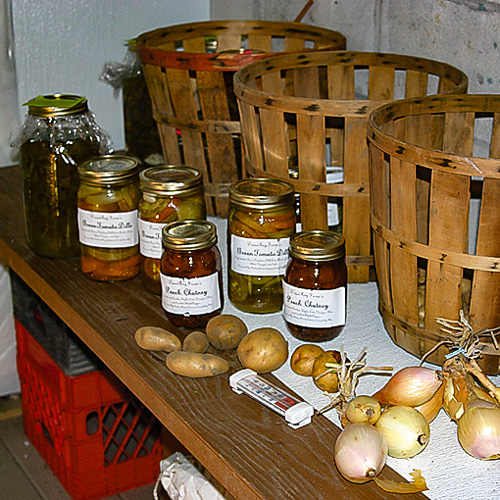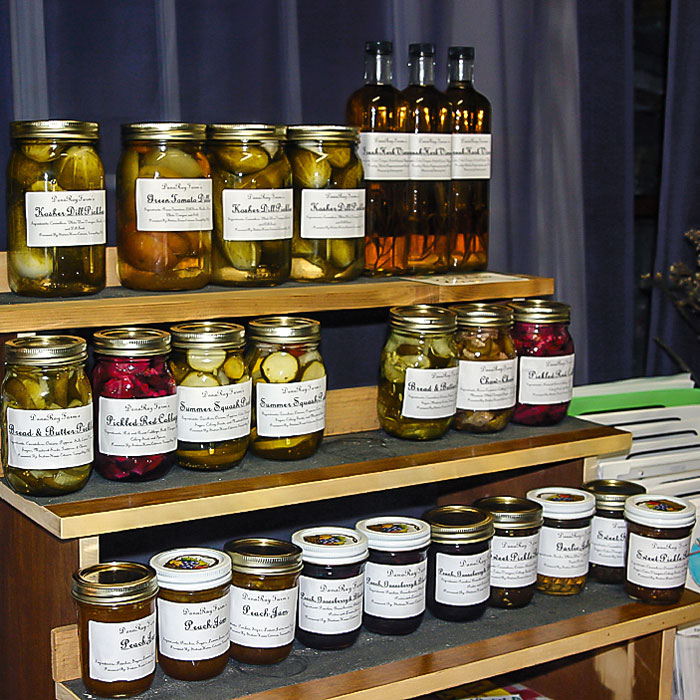Jersey tomatoes! Sweet corn! As the growing season wanes, and preparations for the winter begin, the taste of locally grown produce lingers on our tongues, and is still fresh in our minds. But it is not too late to take advantage of the fall harvest, and "put up" some food for healthy, nutritious eating during the long winter months.
Not so long ago, every family had a root cellar, and canning of all the excess bounty, whether from the home garden or the farm stand, was standard practice. With the advent of the home refrigerator in the 1900s, freezing produce at the peak of just-picked freshness became a simple chore, and cooks filled their freezers with these delectable delights for use all winter long.

Today, with produce shipped to the supermarket from distant warm-weather locales, the necessity of keeping a readily available food supply close at hand has declined. The availability of food in any weather, from almost anywhere in the world, is a given, with no extra planning required.
That also means that our food supply is no longer in our own hands; nor is it in the hands of the farmer down the road. Growing a garden, or even buying from a local farm, is no longer a necessity. But it is a luxury that should be treasured. Ray Eisele, who, with his wife Dana, runs DanaRay farm in Branchville notes that many of his customers now "have an accent. They remember what food is supposed to taste like."
According to the non-profit Foodshed Alliance, based in Blairstown, food travels an average of 1300 miles to get to our tables. Yet, the farmer down the road may have the same type of produce available in-season, just-picked and at the peak of freshness. Besides helping to keep the Garden State green and keeping local food dollars in the community, "seasonal eating" and has added health benefits, as many foods begin to loose nutrients as soon as they are harvested. And supermarket produce is usually bred for shelf-life, not palatability.
By learning to preserve these fresh foods, the local harvest can be enjoyed throughout the winter as well. With a little preparation, the growing season's surplus becomes the off-season's feast! With many methods of preserving food available, the amount of time and commitment needed to enjoy local produce all year long can vary.
The basic methods of food preservation are centuries old. Depending on climate, freezing and drying (dehydration) became the methods of choice. Fermentation and pickling methods were discovered, and then canning became a household activity. The advent of electricity made preservation easier, with a low-cost, low-effort form of preservation readily available with the use of a freezer.
Of course, the most basic food preservation technique involves properly storing the harvest. Success with storage depends upon the quality of the produce, as well as the humidity, the temperature, air flow, and the light conditions of the storage area.
A root cellar uses a relatively humid, dark space, kept at temperatures just above the freezing level, to prolong the life of many of the vegetables and fruits harvested in the fall. These root vegetables include: potatoes, cabbages, turnips, and beets. Even those late fall apples, pears, melons, and end-of-season tomatoes will benefit from cold storage. A cool, moist environment, maintained at proper storage temperatures and humidity levels, can preserve these garden goodies anywhere from a few weeks to a few months!
A root cellar or cold storage area can be a dug-out pit underground, a part of an unfinished, unheated basement, or a specially-built structure. In all circumstances, vigilance is a must: one rotten vegetable will spoil the bunch!

While all these products have slightly different optimal conditions for storage, the basic premise is the same. By choosing undamaged produce and controlling the climate of the storage area, the after-harvest life can be extended by months. Some, such as pumpkins and squash require curing, or storage in warm location prior to being placed in the root cellar. Others need their own special care to ensure freshness.
If maintaining optimum storage conditions sounds like too much hassle, try the easiest method of preservation - freezing. With little preparation, a freezer compartment, and some storage bags, a wide assortment of fruits and vegetables can be readily available all year round.
Vegetables require blanching before they are frozen. This simply entails placing the cut-up produce into boiling water for a very short amount of time, then transferring immediately to ice-cold water, drying, and packing in freezer containers or bags. As much air as possible should be removed from the package. Freeze in family or individual sized portions, or freeze separately on a cookie sheet, then transfer to the container or bag....and "single serve" slices or pieces can be removed as needed.
Fruits also freeze very well. Some, such as berries, can simply be frozen on a cookie sheet and then placed into freezer storage containers. Others, like apples, peaches, and pears, should be sliced, dipped into lemon juice or ascorbic acid to prevent discoloration, and frozen as above. Fruits can also be packed in a simple sugar syrup, or just mixed with sugar, to add sweetness and preserve texture.
Canning is probably the most popular method of food preservation, as cooks everywhere make jams, jellies, sauces, preserves, and fruit butters. Canning beans, beets, squash, spinach, pears, apples, and asparagus might not be as popular a pastime, but it is a reliable method of having these foods available for months after the harvest.

Proper canning procedures include the boiling water and the pressure canning methods, with the recommended method depending upon the acidity of the food. The concern with improper canning is, of course micro-organisms that can cause the food to spoil, as well as serious illness. Therefore, following proper procedures is important, and ensures a safe product. Today, the biology behind food spoilage is understood, and canning is a safe endeavor when done properly.
Drying foods used to be done in the open-air. Then came the oven method. The preferred method today is to use a food dehydrator. Both fruits and vegetables, as well as herbs, can be dried. Nuts, sunflower seeds, and some popcorn can also be dried. Vegetables should be blanched, as with freezing, before dehydrating.
Fully drying the foods, as well as proper air-tight storage to prevent moisture absorption, is important. Dried foods can be frozen for longer storage, or kept at room temperature for several months. Dehydrated foods can be reconstituted by soaking them in water when ready to use.
Fruits should be treated with lemon juice, or a sulfite, to prevent discoloration and spoilage. Dried fruits can also be made into fruit leathers, which are the homemade version of the "fruit rolls" available in the supermarket and popular amongst today's kids.
Fermentation acts as a preservative by allowing non-harmful micro-organisms to grow, which then prevent harmful organisms from proliferating and spoiling the food. It also preserves nutrient value, as lactic acid, alcohol, and acetic acid are all by-products that keep food from losing nutrients. Additionally, fermenting can add nutrients to foods, both by breaking down difficult to digest nutrients into more readily accessible forms, and by adding new nutrients during the biochemical processes of fermentation.
Pickling uses acetic acid, directly produced as the result of bacterial fermentation, to preserve foods. Many vegetables and fruits can be "pickled", although cucumbers are, by far, the most commonly known.
Other well known products of fermentation include beers, wines, and sourdough breads. Sauerkraut is fermented cabbage. Soy sauce is fermented soy beans. Olives are also fermented to tame their inherent bitterness, and yogurt is fermented milk.
Equipment used in fermentation includes croaks or wide-mouth glass jars. To ferment food, water and a fermenting agent, such as salt or vinegar, are added. Time is the most important element, as it can take days to weeks to properly ferment most foods.
Now is the time to run, not walk, to your local farmers' market or on-farm stand. The last peaches and pears ripen in early September. Grapes are harvested in September as well. Apples and raspberries are available into October. There should be some late tomatoes still around, as well as peppers, eggplant, squash, and potatoes through the end of September. Cabbage, broccoli, beets, pumpkins, and cauliflower will all be here for the month of October.
To get started before the fall harvest is history, visit your local library, book store, or the world wide web to find a plethora of resources with step-by-step instructions on food preservation techniques. Or, seek out a neighbor, friend, or local farmer who has been "putting up" food for years. Start slowly, and always follow recommended guidelines. You'll have safe, nutritious, local food, all year long!
Foodshed Alliance
The National Center
for Home Food Preservation
Rutgers Cooperative Extension